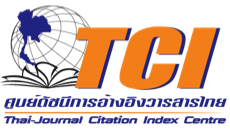PATHWAYS TO SUCCESS: EXAMINING THE INFLUENCE OF ENTREPRENEURIAL POTENTIAL AND BUSINESS MANAGEMENT ON SOUTHERN THAI AGRI-FOOD COMMUNITY ENTERPRISE PERFORMANCE
DOI:
https://doi.org/10.14456/aisr.2025.7Keywords:
Entrepreneurial Potential, Business Management, Performance, Community Enterprises, ThailandAbstract
This study examines the key drivers of community enterprise (CE) success in Thailand's southern border provinces, focusing on CEs processing agricultural products. A mixed-methods approach, combining quantitative and qualitative data, was employed. Quantitative data from 315 entrepreneurs (questionnaires) were analyzed using structural equation modeling (SEM), while qualitative data stemmed from in-depth interviews with nine entrepreneurs. Results reveal a robust positive relationship between entrepreneurial potential and business management effectiveness. Entrepreneurial potential, including risk-taking, proactiveness, and innovation, directly strengthens business management capabilities. Strong business management, encompassing production, marketing, financial, and human resource functions, significantly boosts CE performance (sales, profits, growth). The SEM model, explaining 74.3% of the performance variance, shows business management mediates the relationship between entrepreneurial potential and performance. Qualitative data strongly corroborate these findings, underscoring the vital role of entrepreneurial vision, resource allocation, and adaptability in achieving long-term CE success. This research emphasizes the necessity of interventions aimed at enhancing both entrepreneurial skills and business management practices within these CEs. The findings offer valuable guidance for policymakers and development organizations supporting rural CEs. Future research could explore external environmental factors and comparative analyses across diverse CE types.
Downloads
References
Anusonphat, N., & Poompurk, C. (2022). New Normal Ways for the Survival and Adaptation of Community Enterprise after Covid-19 Crisis of Thailand. Journal of MCU Nakhondhat, 9(1), 1-19.
Baedcharoen, I., Aksorntap, A., & Jatuprayoon, C. (2022). Success Factors of Managing the Gold Color Longan Flesh Processing Community Enterprise Management in Ban Thi Sub-District, Ban Thi, Lamphun Province. Payap University Journal, 32(2), 82-98.
Barney, J., & Hesterly, W. (2008). Strategic Management and Competitive Advantage (2nd ed.). New Jersey: Pearson Prentice Hall.
Barney, J., Ketchen, D., & Wright, M. (2011). The Future of Resource-Based Theory: Revitalization or Decline?. Journal of Management, 37(5), 1299-1315.
Basco, R., Hernández-Perlines, F., & Rodríguez-García, M. (2020). The effect of entrepreneurial orientation on firm performance: A multigroup analysis comparing China, Mexico, and Spain. Journal of Business Research, 113, 409-421.
Byrne, B. (2010). Structural equation modeling with AMOS: Basic concepts, applications, and programming (2nd ed.). London: Routledge.
Chatwanichul, P., Thanawut, S., & Phochathan, S. (2022). Management of Community Business and Business Management Strategy Affects Operations of Community Business in Nakhon Ratchasima Province. NRRU Community Research Journal, 16(1), 194-205.
Community Enterprise Promotion Division. (2022). Summary of the number of Community Enterprises and Community Enterprise networks that have been approved for registration. Retrieved from www.sceb.doae.go.th/Documents/STC/300965.pdf.
Cronbach, L. (1984). Essentials of psychological testing (4th ed.). New York: Harper & Row.
Department of Agricultural Extension. (2022). Report summarizing the types of community enterprises/community enterprise networks classified by area. Bangkok: Department of Agricultural Extension.
Gerdsuk, C. (2022). Marketing Strategy Management of Parcell Transportation Companies Impact Customer Decision-Making on Using Service in Bangkok Metropolitan Areas. Journal of Roi Kaensarn Academi, 7(10), 228-245.
Gumpert, D. (2003). How to Really Create a Successful Business Plan: A Step-By-Step. Massachusetts: Lauson Publishing.
Hair, J., Black, W., Babin, B., & Anderson, R. (2010). Multivariate Data Analysis (7th ed.). New York: Pearson.
Hernández-Linares, R., Kellermanns, F., López-Fernández, M., & Sarkar, S. (2020). The effect of socioemotional wealth on the relationship between entrepreneurial orientation and family business performance. BRQ Business Research Quarterly, 23(3), 174-192.
Intanam, N., Pokha, A., & Donsophon, K. (2020). The Effect of Entrepreneurial Orientation on Business Success of Small and Medium Entreprises in Kalasin Province. Journal of Accountancy and Management, 12(4), 82-95.
Kaplan, R., & Norton, D. (1996). Strategic Learning: The Balanced Scorecard. Strategy & Leadership, 24(5), 18-24.
Khammadee, P. (2023). The Relationship Between E-HRM Practices and Organizational Performance: The Mediating Role of Organizational Agility and Sustainable Competitive Advantage. Asian Administration and Management Review, 6(1), 82-94.
Lumpkin, G., & Dess, G. (1996). Clarifying the Entrepreneurial Orientation Construct and Linking It to Performance. The Academy of Management Review, 21(1), 135-172.
Maneenin, P., & Kamphaengdee, S. (2025). Factor Analysis of Community Enterprises Producing Processed Agricultural Products in the Three Southern Border Provinces. Thai Interdisciplinary and Sustainability Review, 14(1), Article 1.
Office of the National Economic and Social Development Council. (2022). Preparation of the 13th National Economic and Social Development Plan. Retrieved from www.nesdc.go.th/main.php.
Phonphotthanamat, W. (2022). A Comparative Study of Verifying the Content Validity of a Research Instrument with the IOC, CVR and CVI. RSU Library Journal, 28(1), 169-192.
Saelee, A., & Jadesadalug, V. (2015). Effect of Business Management Potential and Entrepreneur’s Personality on Cassava Entrepreneur’s Success in Bo Phloi District, Kanchanaburi Province. Lampang Rajabhat University Journal, 4(2), 1-12.
Schumacker, R., & Lomax, R. (2010). A beginner's guide to structural equation modeling (3rd ed.). London: Routledge.
Secretariat Office of Community Enterprise Promotion Board. (n.d.). Community Enterprise. Retrieved from www.sceb.doae.go.th/Ssceb2.htm.
Tansiri, P. (2023). The Focus on Entrepreneurial Orientation, Innovation Capability, and Risk Taking Affect the Competitive Advantage through Online Channels in Kluaynamthai Innovation District. APHEIT Journals, 29(1), 95-110.
Wongrat, K. (2021). Developing a Causal Relationship Model of Entrepreneurial Orientation and Business Innovation Capabilities to Influence the Performance of the Manufacturing Industry in Phetchaburi Province. Journal of Graduate Studies Valaya Alongkorn Rajabhat University, 15(2), 27-39.

Downloads
Published
How to Cite
Issue
Section
License
Copyright (c) 2025 Authors

This work is licensed under a Creative Commons Attribution-NonCommercial-NoDerivatives 4.0 International License.











.png)


